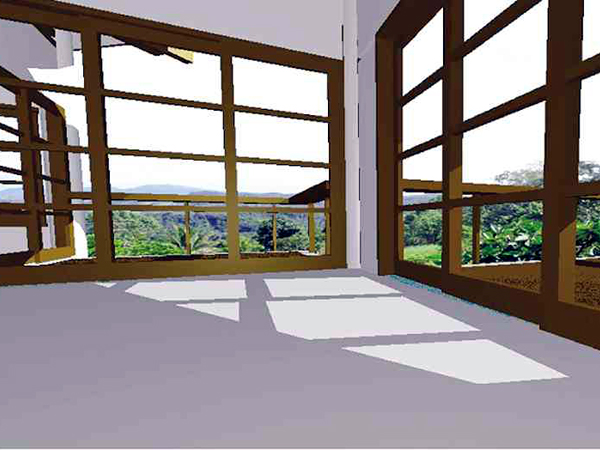
COMPOSITE image of actual site with the 3D CAD rendering of vacation house simulating the sunlight and shadows at 3 p.m. in December. The building orientation ensures that there is no direct sunlight into the living room even at 3 p.m. Photo: ArchITECT Amado de Jesus & Associates/Green Architecture
Working in a foreign land for many years can be quite stressful. Given the work discipline and hectic schedule in industrialized countries, it seems inevitable that upon retirement, one would seek the quiet and relaxing atmosphere of a vacation house, away from the noise and pollution of a busy metropolis like Metro Manila.
That is exactly what my client did. He and his wife decided to purchase a property outside Manila to build their green retirement house on a farm, meant to keep them physically and mentally active while enjoying the produce from the farm.
Playful concept
In keeping with my clients’ wish that the house maintain an informal and playful atmosphere, the major rooms are positioned at an angle with windows at corners to maximize outdoor view.
High gabled roofs with rustic ceiling planks and exposed rafters give the interiors a country look and an expansive feeling making the rooms look bigger.
The addition of a multipurpose mezzanine adds to the informal atmosphere of the house. It can also be used as an extra room for overstaying guests or simply a play area for children.
The open-type kitchen is an inviting area for the owners and their guests who drop by. It also has a great view and has direct access to the balcony through sliding doors.
An infinity pool, visible from the lower part of the site, is located under one of the balconies and is cantilevered, facing the landscaped front garden.
Sustainable site dev’t
We established the guidelines for the site, which is characterized by a steep incline from the road to the rear of the lot. Once on top, the site affords a majestic view of the mountains and the adjacent properties.
At the onset, it was decided that only minimal cutting of the land will be done except the area around the house which does not have a large building footprint. All utilities like cable lines for lamp posts will be underground.
For land development, the swale system will be adopted. The swale system is a natural way to address the problem of drainage. It is made up of a gently sloping ditch or open canal with grass or gravel, to guide the water as it flows on the side of a road or a structure. As water flows through the ditch, a large quantity is absorbed by the ground, reducing the need for a large and expensive concrete drainage system.
Small, rainwater-collecting ponds along the ditch are placed for irrigation and for slowing down the water flow to prevent soil erosion.
Herbs, fragrant flowers and edible landscaping will dominate the landscape.
The retirement house is designed to collect rainwater not only for irrigation but also for other purposes like cleaning the facilities and for use of the service kitchen.
Natural light, ventilation
Fortunately, the lot orientation is ideal in the sense that the longitudinal side of the house is along the East-West axis, thus minimizing exposure of the main openings to the sun. The orientation also helps to facilitate wind flow.
Computer simulations of solar studies at different times of the day and months show that extensive daylighting can be achieved for the major rooms. Electric lights need not be turned on till very late in the afternoon.
Materials
The materials to be used are easy to clean to minimize maintenance costs. Part of the exterior wall finish will come from the site in the form of rough stones as part of the rustic yet modern look of the house.
The project is aiming for zero waste by reducing, reusing and recycling all solid waste and developing compost to handle wet garbage. A designated area in the site will be used for this including a seedling program.
Energy efficiency
Since most of the windows and sliding doors are facing either north or south, very little solar penetration will occur. This means the house will not be dependent on energy-guzzling air conditioners, although the bedrooms are provided with air conditioners for very hot, humid days. Most of the time, however, it is expected that ceiling fans and wide, wooden French doors will be effective in making the house cool and comfortable during summer.
Provisions for installing solar panels in the future like additional conduits are in place. The house will be connected to the grid. Any additional power needed will come from the grid and anything in excess will be brought back to the grid.
For comments or inquiries, e-mail amadodejesus@gmail.com.